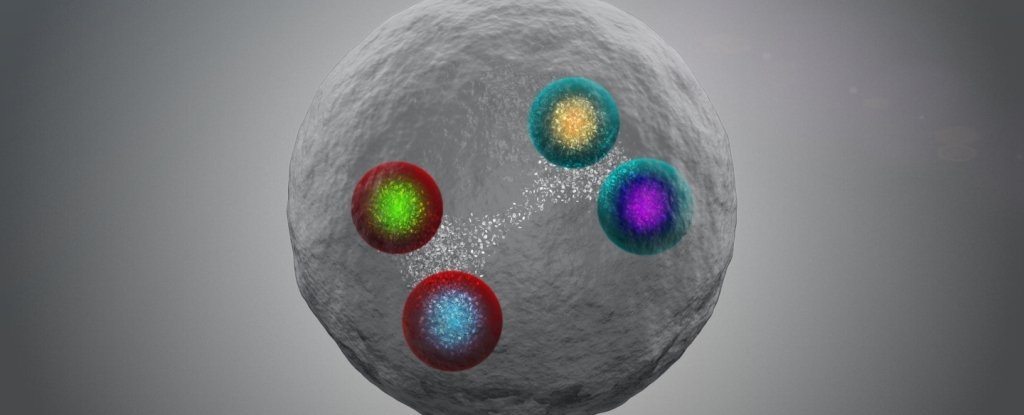Products You May Like
There’s a new exotic subatomic particle on the atom smasher. Physicists working with CERN’s Large Hadron Collider beauty (LHCb) collaboration have found a new form of the elusive four-quark particle called a tetraquark that they have never seen before.
The newly identified particle is made up of four quarks of the same flavour and is likely, scientists say, to be the first of a previously undiscovered class of particles.
The paper describing it has been uploaded to arXiv, and is yet to be peer-reviewed, but joins a growing body of evidence supporting the existence of exotic particles.
Quarks are elementary particles that are one of the fundamental building blocks of matter. Protons and neutrons – the subatomic particles in the atomic nuclei that make up all visible matter (including us) – each contain three quarks, bound together by the strong nuclear force.
Particles that contain other configurations, such as four-, five- and six-quark particles, are a lot rarer (and six-quark particles are still hypothetical). These kinds of particles are so rare that we didn’t even have confirmation of the existence of tetraquarks until just a few years ago.
Quarks can be categorised a few different ways. There are six different types, or flavours – these are up, down, top, bottom, strange, and charm. Each of these flavours has its own antiquark particle. And they have different masses – top, charm, and bottom quarks are the ‘heavy’ quarks.
The configuration of the new tetraquark does two things we’ve never seen before. It consists of four quarks of the same flavour; and all four of those are heavy quarks.
“Particles made up of four quarks are already exotic, and the one we have just discovered is the first to be made up of four heavy quarks of the same type, specifically two charm quarks and two charm antiquarks,” said physicist and outgoing LHCb spokesperson Giovanni Passaleva of the National Institute for Nuclear Physics in Italy.
“Up until now, the LHCb and other experiments had only observed tetraquarks with two heavy quarks at most, and none with more than two quarks of the same type.”
The unusual particle was discovered by going back over the data collected and retained from the Large Hadron Collider’s two operational runs, first from 2009 to 2013, and then from 2015 to 2018 after significant upgrades.
The team combed over this data using a new technique for looking for new particles that involves searching for an excess in collision events. The researchers found this excess for a type of particle called a J/ψ meson, which consists of two quarks – a charm quark and a charm antiquark.
J/ψ meson are, like all mesons, unstable; they decay in less than a zeptosecond, which means they’re challenging to detect directly. What we can detect is the muon particles that J/ψ mesons decay into, and infer their presence that way.
But the muon particle showers the team detected were too energetic for simple decay of J/ψ mesons. Interestingly, however, they were right smack-bang in the middle of the energy range predicted for fully charmed tetraquarks (as the type of particle is rather charmingly known), within the standard deviation threshold for claiming the discovery of a new particle.
It’s still unclear, at this stage, how tetraquarks are structured. It’s possible that they are true tetraquarks, consisting of four quarks tightly bound together. But it’s also possible that they consist of pairs of weakly bound two-quark particles.
The same possibility is true for pentaquarks and hexaquarks – that they consist of bound pairs of smaller particles, rather than one tightly bound particle.
Discovering more of these exotic particles – and more kinds of these exotic particles, such as this new discovery – could help unravel this mystery. In turn, that could shed more light on the strong nuclear force that binds quarks into protons and neutrons, enabling the existence of matter.
“These exotic heavy particles provide extreme and yet theoretically fairly simple cases with which to test models that can then be used to explain the nature of ordinary matter particles, like protons or neutrons,” said particle physicist and new LHCb spokesperson Chris Parkes of the University of Manchester in the UK.
“It is therefore very exciting to see them appear in collisions at the LHC for the first time.”
The team’s paper is available on pre-print website arXiv.
